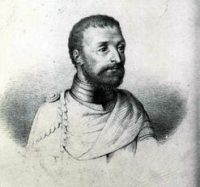[Our ancestors return to Homonhon with more food and drink.]
El viernes, día veintidós del mes, cumplieron los isleños su palabra, llegando con dos canoas llenas de cocos, naranjas y un cántaro repleto de vino de palma y un gallo para manifestarnos que tenían gallinas. Compramos todo lo que trajeron. Su jefe era un anciano, con el rostro pintado y pendientes de oro en las orejas; y los de su séquito traían en los brazos brazaletes de oro y pañuelos que les rodeaban la cabeza.
Pasamos ocho días en esta isla, yendo el comandante diariamente a tierra a visitar a los enfermos, llevándoles vino de cocotero, que les probaba muy bien.
Los habitantes de las islas inmediatas a aquella en que estábamos, usaban en las orejas unos agujeros tan grandes y las tenían tan prolongadas, que por él se podía pasar el brazo.
Estos pueblos son cafres, esto es, gentiles. Andan desnudos, cubriendo sólo sus órganos sexuales con un trozo de corteza de árbol, y algunos jefes con un pedazo de tela de algodón, bordada con seda en sus dos extremos. Son de color oliváceo y generalmente bastante obesos. Se pintan y se engrasan todo el cuerpo con aceite de cocotero y de jenjelí, para preservarse, según dicen, del sol y del viento. Tienen los cabellos negros y los llevan tan largos que les caen sobre la cintura. Sus armas son cuchillos, escudos, mazas y lanzas guarnecidas de oro. Como instrumentos de pesca usan dardos, arpones y redes hechas más o menos como las nuestras. Sus embarcaciones se asemejan también a aquellas de que nos servimos.
[54] At noon on Friday, 22 March, those men came as they had promised us in two boats with coconuts, sweet oranges, a jar of palm wine, and a cock, in order to show us that there were fowls in that district. They exhibited great signs of pleasure at seeing us; we purchased all those articles from them. Their lord was an old man who was tattooed, and he wore two gold earrings in his ears, and the others many gold armlets on their arms and kerchiefs about their heads. We stayed there eight days, and during that time our captain went ashore daily to visit the sick, and every morning gave them coconut water from his own hand, which comforted them greatly. There are people living near that island who have holes in their ears so large that they can carry their arms in them. Those people are Kaffirs, that is to say, heathen; they go naked, with a cloth woven from the bark of a tree about their private parts, except some of the chiefs who wear cotton cloth embroidered with silk at the ends by means of a needle. They are olive skinned, fat, and tattooed, and they anoint themselves with coconut and with beneseed oil as a protection against sun and wind; they have very black hair that falls to the waist, and they use daggers, knives, and spears ornamented with gold, large shields, focine, javelins, and fishing nets that resemble rizali. Their boats are like ours.
Pagsapit ng tanghali ng Biyernes, 22 Marso, bumalik ang mga laláki, tulad nang kaniláng naipangako, sa dalawang bangkang may mga lulang buko, matatamis na kahel, isang garapon ng alak ng niyog, at isang tandang, upang ipakita sa amin na may mga manok sa distritong iyon. Nagpamalas silá ng matinding sayá sa pagkakakita sa amin. Binili namin ang lahat ng mga bagay na ito. Pintado [de-tatô] ang kaniláng pinunò. Suot niya ang dalawang hikaw, at ang ibá ay may gintong pulseras sa braso at bandana sa ulo. Nanatili kami doon nang isang linggo, at sa panahong iyon, dumadaong ang aming kapitán bawat araw upang dalawin ang mga maysakit, at bawat umaga ay binibigyan niya silá mula sa sariling niyang kamay ng katas ng buko, na siyá namang nagdulot sa kanilá ng malaking ginhawa. May mga táong naninirahan malápit sa islang iyon na maysuot na mga hikaw na sa laki ay maaaring paglusutan ng kaniláng mga braso. Ang mga táong iyon ay caphri, ibig sabihin, pagano. Hubo’t hubad silá, at tinatakpan ang mga ari ng telang hinabi mula sa balát ng punò, maliban sa ilang pinunò na nagsusuot ng telang bulak na binurdahan ng seda sa mga dulo gámit ang isang karayom. Silá ay maitim, mataba, at pintado. Binabasbasan nilá ang mga sarili ng langis ng buko at beneseed, bílang pananggalang sa araw at hangin. Mayroon siláng napakaitim na buhok na hanggang baywang ang habà, at gumagamit ng mga punyal, kutsilyo, at sibat na dekorado ng ginto, malalakíng kalasag, fascine, habalina, at mga lambat-pangingisda na katulad ng rizali, at ang mga bangka nilá ay katulad nang sa atin.
